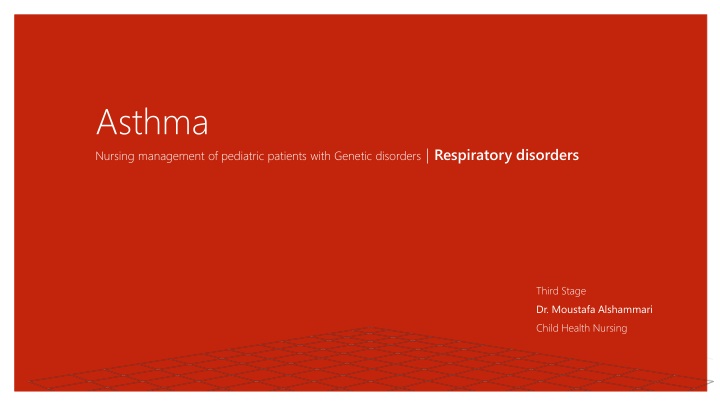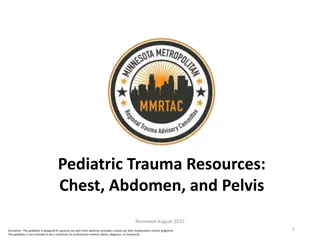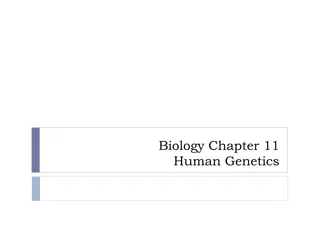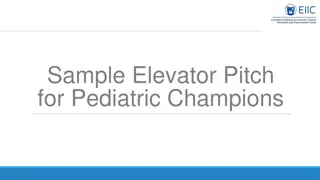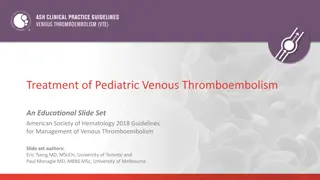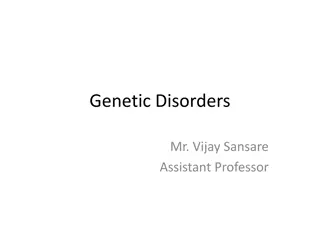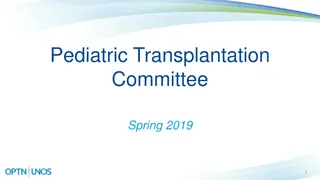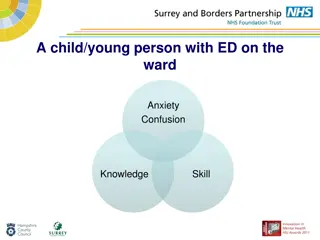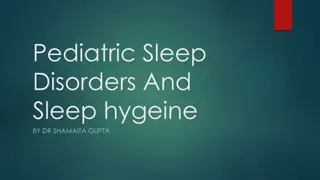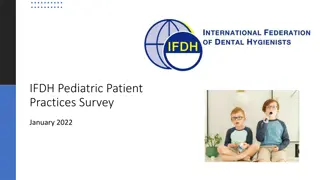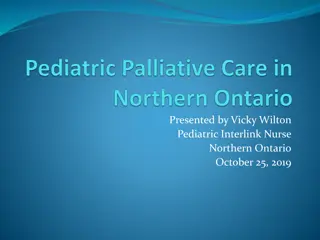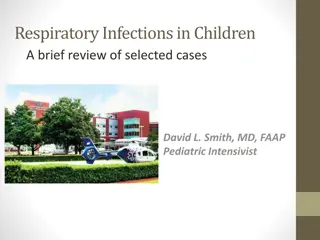Nursing Management of Pediatric Patients with Genetic Disorders
Asthma is a recurrent and reversible lung condition that causes airway obstruction due to various stimuli. It is more common in males up to adolescence, then reverses with females being more affected. Non-allergic precipitating factors include bronchial compression, foreign body in airway, endobronchial inflammation, and post-exercise bronchial constriction. Hypersensitivity to foreign substances and plant pollens, as well as a family history of allergies, play a role in the etiology. Pathophysiology involves inflammation, edema, and mucus accumulation in the airways, leading to symptoms like coughing, shortness of breath, and wheezing.
Download Presentation

Please find below an Image/Link to download the presentation.
The content on the website is provided AS IS for your information and personal use only. It may not be sold, licensed, or shared on other websites without obtaining consent from the author.If you encounter any issues during the download, it is possible that the publisher has removed the file from their server.
You are allowed to download the files provided on this website for personal or commercial use, subject to the condition that they are used lawfully. All files are the property of their respective owners.
The content on the website is provided AS IS for your information and personal use only. It may not be sold, licensed, or shared on other websites without obtaining consent from the author.
E N D
Presentation Transcript
Asthma Nursing management of pediatric patients with Genetic disorders | Respiratory disorders Third Stage Dr. Moustafa Alshammari Child Health Nursing
Asthma Asthma Is a recurrent and reversible condition of the lung where there is airway obstruction due to spasm of the bronchial smooth muscle, edema of the mucosa, and increased mucus secretions in the bronchi and bronchioles that has been caused by various stimuli. (continued)
Asthma More common in males up to adolescence then it is reversed and females become more affected It is the most common cause of school absences and form a major portion of admission to emergency room and hospitals
Etiology Non allergic precipitating factor: Bronchial compression from external pressure Foreign body in the air way Diffuse endobronchial inflammation Post exercise bronchial constriction
Etiology Hypersensitivity to foreign substances, plant pollens Family history of allergy suggest genetic basis
Pathophysiology Mechanism that produce symptoms: Inflammation and edema of the mucus membrane Accumulation of tenacious secretions from mucus glands Spasm of the smooth muscle of the bronchi and bronchioles which decrease the diameter of the bronchioles
Pathophysiology Mechanism that produce symptoms: The sequence of these mechanisms is not the same in all patients These obstructive processes interfere with ventilation and result in characteristic symptoms of: coughing, shortness of 'breath and wheezing
Pathophysiology Mechanism that produce symptoms: Inspiration: normally the bronchi dilate and elongate during inspiration Expiration: bronchi contract and shorten.
Pathophysiology Mechanism that produce symptoms: Following an inflammatory process caused mostly by allergens the obstruction will increase causing forced expiration through the narrowed lumen The air trapped in the lung increase (the obstruction is between the alveoli and the lobar bronchi)
Pathophysiology Mechanism that produce symptoms: The obstruction forces the patient to breath at a higher and higher lung volume The patient fight to inspire leading to fatigue Decrease respiratory effectiveness cause increase 02 consumption
Pathophysiology Mechanism that produce symptoms: Also inspiration occur at higher lung volume that lead to hyper inflate the alveoli With increased obstruction C02 increase leading to hypoxia, respiratory acidosis and ending in respiratory failure
Factors contributing to the pathologic mechanisms responsible for airway obstruction asthma: Internal triggers: External triggers: Pollens Exercise Dust & Pollution Infection Mold Stress Dander
Incidence Common age 3 and above In young children incidence is high in males Equal sex incidence in adolescence Decrease in puberty 3% of school children have symptoms of asthma. in urban indwellers than rural.
Clinical manifestations: Onset may be gradual with nasal congestion, sneezing and watery nasal discharge before the attack Attack may occur suddenly mostly at night with: Wheezing primarily with expiration Anxiety and apprehension diaphoresis
Clinical manifestations: Uncontrollable cough, dry at first then productive (frothy, clear, gelatinous sputum) Dyspnea with increased effort during expiration Shortness of breath Prolonged expiratory phase Audible wheeze Pale appearance - but may be flushed cheeks and red ears, and lips deep red color
Clinical manifestations: May progress to cyanosis of nail beds and circumoral area Restlessness - apprehension Anxious facial expression Sweating May sit upright, shoulders in a hunched over position hands on bed or chair
Clinical manifestations: Speaks with short, panting broken phrases Chest: hyper resonance on percussion Coarse, loud breath sounds Wheezing through out the lung field Prolonged expiration Crackles Generalized inspiratory and expiratory wheezing increasingly high pitched
Clinical manifestations: With repeated episodes: "Barrel (pigeon ) chest - elevated shoulders-Use of accessory muscles of respiration Facial appearance: flattened molar bones, and circles beneath the eyes
Risk Assessment Prior ICU admissions Prior intubation >3 emergency department visits in past year >2 hospital admissions in past year >1 bronchodilator used in past month
Risk Assessment Use of bronchodilators > every 4 hours Chronic use of steroids Progressive symptoms in spite of aggressive Rx
Diagnosis History of symptoms. and physical examination Barrel chest- Chest X-Ray shows hyper expansion of airways Pulmonary function tests show air trapping and decreased expiratory flow measurement of forced expiratory volume at one second (FEV1)
Diagnosis Respiratory volume (RV) and Total lung capacity (TLC) 5. Blood: CBC 6. Routine skin and sputum testing may help determine allergic causes
Treatment: Objective is to relieve symptoms and improve ventilation capacity: Bronchodilators: I.V Aminophyline. S.C Epinephrine. Corticosteroids reduce the inflammatory component of bronchial obstruction, decrease mucus production and mediator release, as well as the late phase (cellular) inflammatory process.
Treatment: Objective is to relieve symptoms and improve ventilation capacity: Methyl prednisone IV in severe cases May need Reglan if experiencing GI upset PO prednisone always give with food to decrease GI upset
Treatment: Continuous assessment of respiratory status: Blood gas studies Maintain patent air way and oxygenation, suction of viscous secretions, ensure humidity and position correctly. Re-establish and maintain fluid and electrolyte balance Cardiac monitoring (increased B/P & Rt sided heart failure and arrhythmias may develop)
Treatment: Maintain bed rest and physical comfort Parental reassurance Anti-inflammatory agents and expectorants given as indicated Intubations and ventilation if necessary
Long term care: Objective Prevention of acute attacks - Decrease school absence Minimal medications and treatment Participation in normal activities Normalization of pulmonary function tests Promotion of normal growth and development.
Long term care: Objective Removal of suspected stimuli Desensitization to build the patient's resistance to allergen Drug therapy to control symptoms Physiotherapy - Bronchial drainage - Breathing exercises Supportive treatment: Hydration
Long term care: Objective Oxygen therapy when needed Treatment of infection Correcting Acid - Base balance Relieve fatigue
Nursing considerations: Assessment of the respiratory system: Observation - Inspection - Palpation - Auscultation - Percussion Some physical characteristics: Chest configuration Posturing Breathing assessment and finger clubbing
Nursing considerations: Psychological assessment: Assess the degree to which the disorder interferes with every day living activities. 4. Coping of the child and family with the condition altered self concept 5. The comply to treatment?????????
Nursing diagnosis: Ineffective breathing pattern RlT allergic response in bronchial tree Activity intolerance RlT imbalance between oxygen supply and demand Altered family process RlT having a child with a chronic illness
Evaluation 1. Formulate a care plan for the infant with Asthma? 2. Describe the nursing care of the child with Asthma? 3. Formulate a plan for teaching parents of the child with Asthma?
Thankyou You can find me at:
